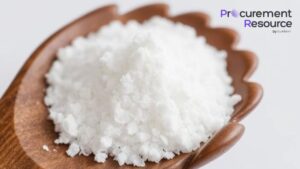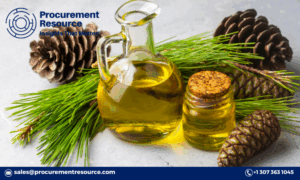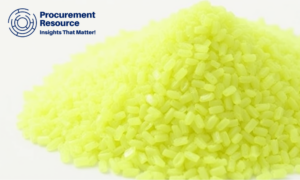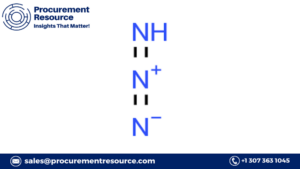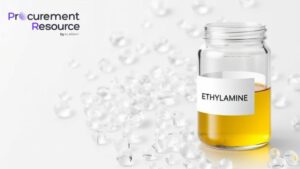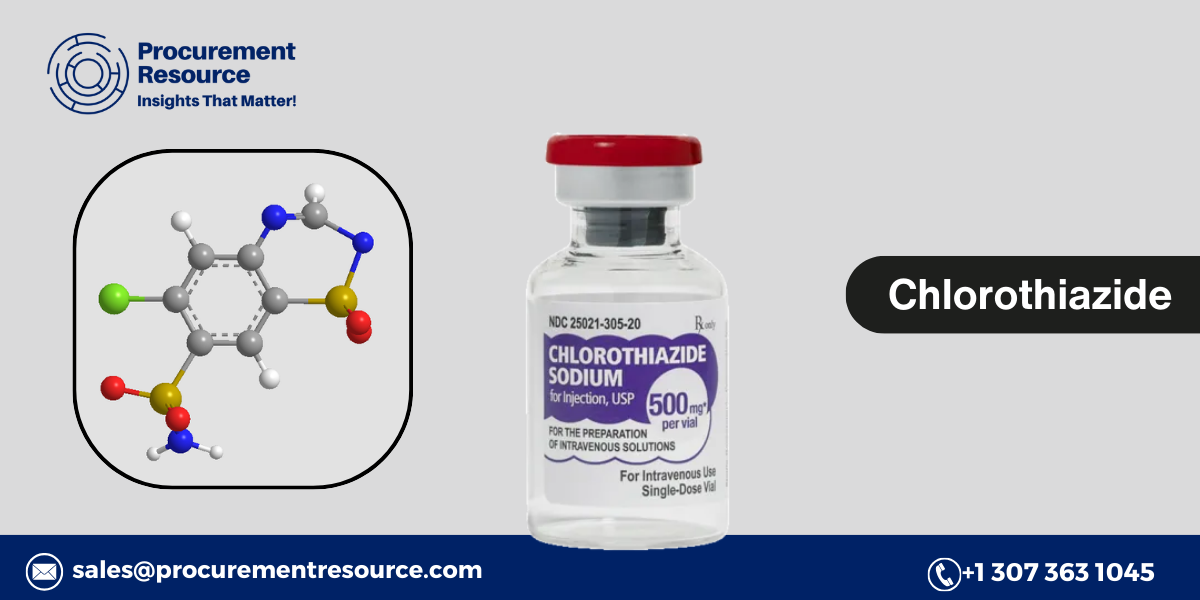
Chlorothiazide Production Cost
Chlorothiazide is a thiazide diuretic used primarily in the treatment of hypertension (high blood pressure) and edema associated with various medical conditions. By reducing the amount of water retained by the kidneys, chlorothiazide helps lower blood pressure and decrease swelling. The drug is commonly produced in tablet and injectable forms, making it an important medication in both primary care and hospital settings. The chlorothiazide production cost involves complex chemical synthesis and requires strict quality control to ensure purity, efficacy, and safety. Understanding the production costs associated with chlorothiazide is essential for manufacturers, especially those looking to optimize costs while maintaining high standards.
Key Components of Chlorothiazide Production Cost
The production of chlorothiazide involves several stages, each with its own associated costs. Major cost categories include raw materials, synthesis and processing, labor, equipment, quality control, regulatory compliance, and environmental management.1. Raw Material Costs
- Chemical Precursors:
- The production of chlorothiazide starts with sourcing various chemical precursors needed for synthesis. Common starting materials include substituted benzenes and sulfonamide compounds, which are essential for creating the benzothiadiazine ring structure that characterizes chlorothiazide.
- Prices of these raw materials can fluctuate based on supply chain factors, availability, and global demand for petrochemical feedstocks, since many organic precursors are petroleum derivatives.
- Reagents and Catalysts:
- Several reagents, such as sulfuryl chloride and hydrazine, are used in the synthesis of chlorothiazide. Catalysts, which may be metal-based, are also required for certain reactions. These materials can be expensive, especially when high-purity reagents are necessary to ensure consistent quality.
- Reagents and catalysts are typically used in smaller quantities than primary precursors, but they are often costly due to their specialized nature and the precision required in their production.
- Solvents:
- Organic solvents, such as acetone, methanol, and ethyl acetate, are necessary to facilitate reactions and purify the chlorothiazide. Solvents are chosen based on their compatibility with the reaction, solubility properties, and ease of separation.
- The cost of solvents depends on the volume used and whether they can be recovered and reused. Solvent recycling systems can reduce expenses, but they also require initial investment and maintenance.
2. Synthesis and Processing Costs
- Chemical Synthesis:
- Chlorothiazide production involves multiple steps of chemical synthesis to construct the benzothiadiazine ring and introduce the sulfonamide functional group. This process typically includes reaction stages, such as chlorination, sulfonation, and cyclization, which must be carefully controlled to produce high-purity chlorothiazide.
- The complexity of the synthesis impacts labor costs, as skilled chemists and technicians are needed to monitor and adjust reaction conditions. Synthesis costs also include energy for heating, cooling, and agitation.
- Purification and Isolation:
- Once synthesized, chlorothiazide must be purified to remove any unreacted starting materials, by-products, and impurities. Purification methods may include crystallization, filtration, and liquid-liquid extraction.
- Purification requires additional solvents and reagents, as well as equipment like centrifuges and filtration systems. These processes add to production costs due to the need for energy, additional materials, and specialized equipment.
- Drying and Milling:
- After purification, the chlorothiazide is often dried to remove residual solvents. This may involve the use of drying ovens or vacuum dryers. Milling is also necessary to achieve the desired particle size for formulation into tablets or injectable products.
- Drying and milling equipment consume energy and require maintenance, contributing to overall production expenses. Additionally, these stages require a controlled environment to prevent contamination and maintain product quality.
3. Labor Costs
- Skilled Chemists and Technicians:
- The production of chlorothiazide requires skilled labor, including chemists to oversee the synthesis and technicians to operate specialized equipment. These personnel are essential for ensuring proper reaction conditions, performing quality control tests, and monitoring the overall production process.
- Labor costs vary depending on the geographic location of the production facility, the availability of skilled workers, and the degree of automation in the manufacturing process. More specialized labor is generally more costly, but it ensures consistency and high quality in production.
- Quality Control Staff:
- Quality control (QC) is critical in pharmaceutical production, as it ensures the final product meets all required safety and efficacy standards. QC personnel conduct tests throughout production, including tests for purity, potency, and stability.
- QC testing is labor-intensive and requires highly trained staff to perform analytical tests, such as high-performance liquid chromatography (HPLC) and gas chromatography (GC), which add to labor expenses.
4. Equipment and Maintenance Costs
- Synthesis Reactors and Vessels:
- Synthesis reactors and reaction vessels are essential for chemical synthesis. These vessels need to withstand high temperatures, pressures, and potentially corrosive substances. Reactors are significant capital investments and require routine maintenance, including inspection, cleaning, and part replacements.
- Maintenance costs vary based on reactor type and usage frequency. For instance, stainless steel reactors used for chlorothiazide synthesis may require specific maintenance procedures due to the chemical reactions involved.
- Filtration and Separation Equipment:
- Filtration equipment, such as centrifuges, and separation technologies, like liquid-liquid extraction systems, are necessary to purify chlorothiazide. These machines require regular servicing and can be expensive to replace if damaged.
- Maintenance includes periodic cleaning, lubrication, and part replacement to ensure consistent operation and prevent contamination of the final product.
- Analytical Equipment:
- QC testing relies on analytical equipment, including HPLC, GC, spectrophotometers, and titration instruments. These machines are expensive to purchase and require calibration, regular servicing, and occasional upgrades to maintain accuracy and reliability.
- Analytical equipment requires significant investment, both upfront and ongoing, for maintenance and replacement as technology evolves.
5. Quality Control and Regulatory Compliance Costs
- Quality Assurance and Testing:
- The pharmaceutical industry has stringent requirements for quality assurance. Chlorothiazide must be tested for purity, potency, and compliance with regulatory standards. Quality testing involves several stages, from raw material inspection to final product verification.
- Testing requires materials such as solvents and reagents, as well as trained personnel. The use of consumables, such as columns and filters in HPLC systems, also adds to the cost of QC operations.
- Regulatory Compliance:
- Compliance with regulatory requirements is essential for chlorothiazide production. This includes adhering to Good Manufacturing Practices (GMP) and ensuring that all production processes meet safety and efficacy standards set by regulatory bodies like the FDA or EMA.
- Compliance costs include facility inspections, documentation, and licensing fees, as well as the cost of maintaining regulatory records. Additionally, companies may need to conduct stability studies and submit product samples for review, adding to overall expenses.
6. Environmental and Waste Management Costs
- Waste Disposal:
- The production of chlorothiazide generates chemical waste, including unused reagents, spent solvents, and by-products. Disposal must be handled according to environmental regulations, as many of these wastes are hazardous and require special treatment.
- Waste disposal costs depend on the types and quantities of waste produced, as well as local disposal fees. On-site waste treatment facilities can help mitigate these costs, but they require an initial investment and ongoing maintenance.
- Emissions Control:
- Emissions from chlorothiazide production, including VOCs and other airborne contaminants, may require control systems to ensure that emissions meet environmental standards. Emission control systems, such as air scrubbers and activated carbon filters, help reduce the environmental impact but represent additional costs.
- Maintaining these systems involves regular inspection, filter replacement, and operational costs to ensure that emissions are kept within legal limits.

